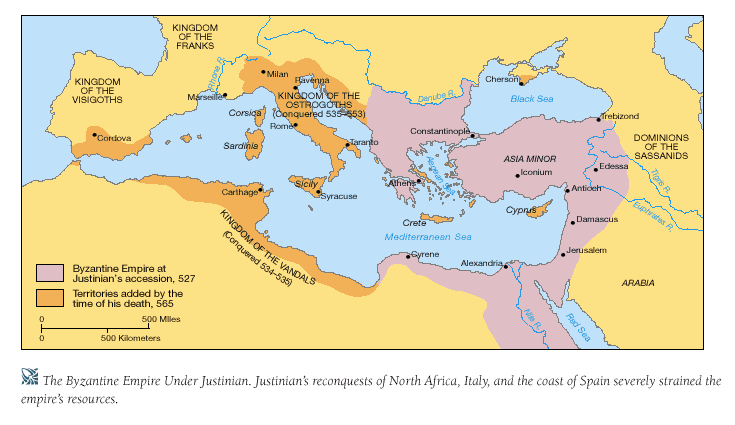To understand what I'm trying to do during this trip, I think I need to explain some (very basic) Byzantine History. Don't worry, it won't be too long. I'll try not to bore you.
Although the Roman Empire collapsed in Western Europe during the 5th century, in the East it continued for another 1000 years. This is what I mean when I talk about the Byzantine Empire: the Eastern Roman Empire, whose capital was Constantinople, and which eventually was defeated by the Ottoman Turks in 1453 AD.
So, if the Byzantines were in the Eastern Mediterranean, what do they have to do with Italy? In the 6th century the Byzantine emperor Justinian decided to reconquer the Western Roman Empire, taking it back from the "barbarian" Goths and Vandals.
As you can see from that map, he was pretty successful: all those areas in orange had been under the control of Germanic kings, and over the course of his just under 40 year reign, Justinian retook them all. A lot of these areas were quickly lost again, particularly to the Muslims in the 7th and 8th century, but that's not important for my purposes. The Byzantines clung to parts of Italy all the way up until the fall of Bari in 1071 AD, over 500 years after Justinian's death.
Being in Italy that long, the Byzantines surely left a mark. But, Byzantine Italy is virtually unknown to the modern tourist; a lot of the best sites are in the South of Italy, far from the big 3 of Venice, Florence, and Rome. Travelers to Venice get a glimpse: the Basilica di San Marco is built in the Byzantine style. The biggest difference is that Venice as a political entity was more independent. A lot of the cities I'll be visiting in Southern Italy were directly controlled by the Byzantines. Byzantine Italy isn't given much attention even by historians. The medievalists don't want to get involved with Byzantine History, since the sources are so different (not to mention that you have to know Greek), and the Byzantinists focus on other areas of the empire. There are a few sites that are reasonably well known, but the Western edge of the Byzantine Empire just doesn't get the attention that the Balkans and Asia Minor do, for example.
So, for this trip, I'm going to be traipsing through Italy, trying to find bits of Byzantium that still survive, as well as Byzantine influence on their conquerors (even today, there are communities in Southern Italy who speak primarily Greek). I'm mainly going to be looking at ecclesiastical and secular architecture, as well as art. Even though both areas were predominantly Christian, artistic style varied quite a between the West and the East. Take a look at these two cathedrals, as an example:
These churches are roughly contemporary. Both are from the 12th century and in fact, both were constructed by the Normans. The top picture is of the Duomo di Monreale in Sicily, and the bottom is of Hereford Cathedral in England. The difference is that Monreale was built with the help of Byzantine craftsmen, who had a huge influence on the style of the building. Monreale is a particularly splendid example, but I'm going to be looking for buildings like this on a less fantastic scale, to try to gauge how pervasive Byzantine influence was, especially after the Normans controlled the peninsula.
So, I hope that wasn't too boring. I think that with a little basic background the pictures I take and descriptions I give will make a little more sense. I also hope that I explained everything well enough; if you have a question, leave it in the comments and I'll try to answer it.


This comment has been removed by a blog administrator.
ReplyDeleteCool and I have a tremendous proposal: How Much Is Home Renovation home improvement near me
ReplyDelete